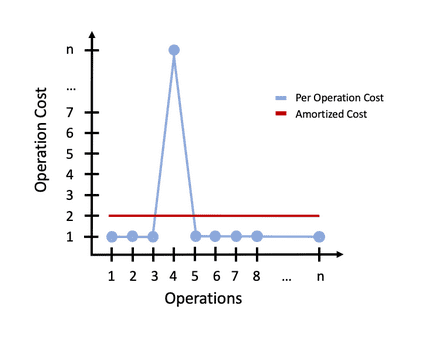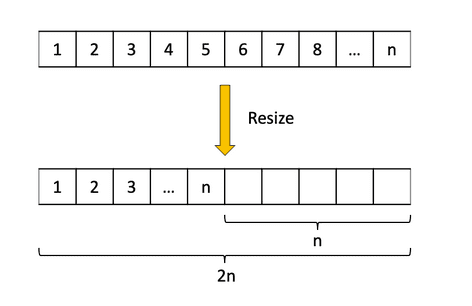amortized operation analysis
"spreading cost over time" is the key takeaway for amortized operations.
Arraylist example
When adding to an arraylist we occassionally have resizes that are O(n); however, all other additions are O(1) - effectively spreading costs over the life of the list.
Calculating amortized cost
- Instead of looking at per operation cost we look at all sequences of n operations and avg. the cost over the #
Arraylist calculation:
When adding to the back of an arraylist there are 2 cases to consider
- Resize
- O(n) work to be done
- No resize
- O(1) work to be done
// Sequence of data being added to the ArrayList with no resize operations
Amortized cost = total cost of all operations / # of operations
= 2n / n
= 2
= O(1)
-
Once an arraylist is resized there are "n" new empty cells to occupy before the next operation
- after "n" operations we can't trigger another resize in that window
- for every sequence of "n" operations we can only trigger a resize once
-
resize cost is "2n" units of time, as we have to:
- copy them
- place them at a new index
// Sequence of data being added to an arraylist with a resize operation
Amortized cost = total cost of all operations / # of operations
= (resize cost + normal operation cost) / n
= (2n + 2n) / n
= 4
= O(1)
Soft v. hard removals
In many array-based data structures you will have the option of a hard removal or soft removal
-
hard removal - ensure that the data you removed is completely removed from the backing structure
- this implies if you search the array the data is gone
- in an arraylist this is done naturally by the shifting process; however, may have to be done by setting a
nullposition for hard removal
-
soft removal - leaving the data in the data structure unless it is necessary to get rid of it
- in the arraylist the "end" of the list is controlled by the size variable
- we can technically just change the size of the arraylist without removing the data, if it isn't required
- in the arraylist the "end" of the list is controlled by the size variable
-
for this course we will generally do hard removals
- primarily hard removals are used for sensitive data
- also helps to make the implementation itself cleaner

